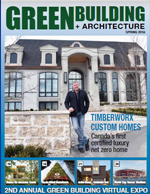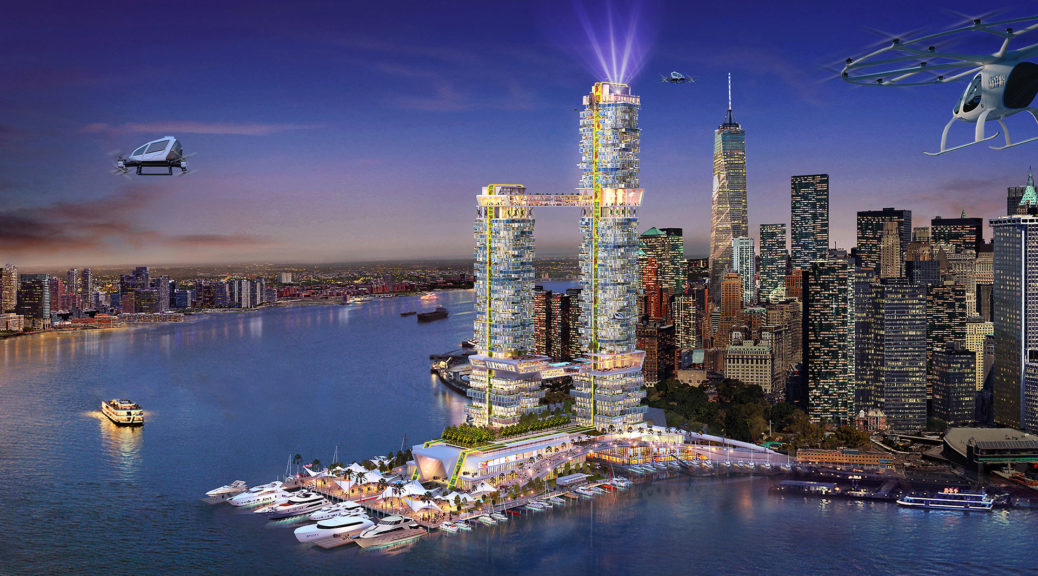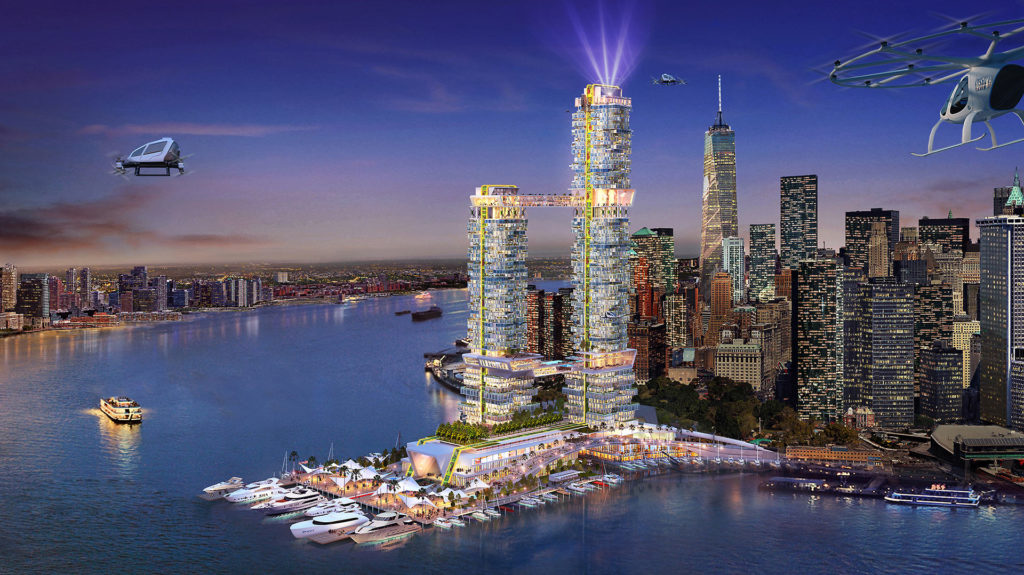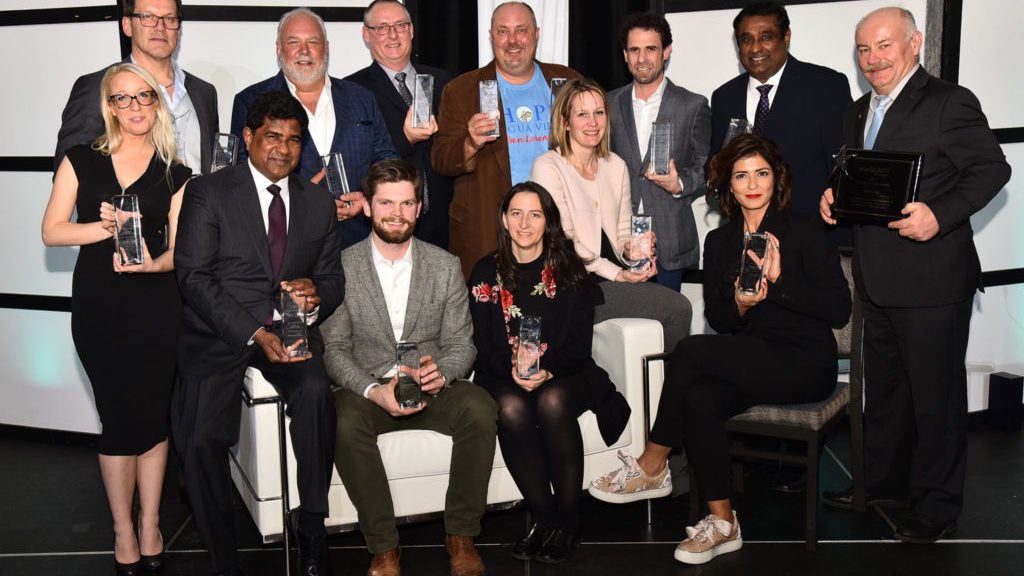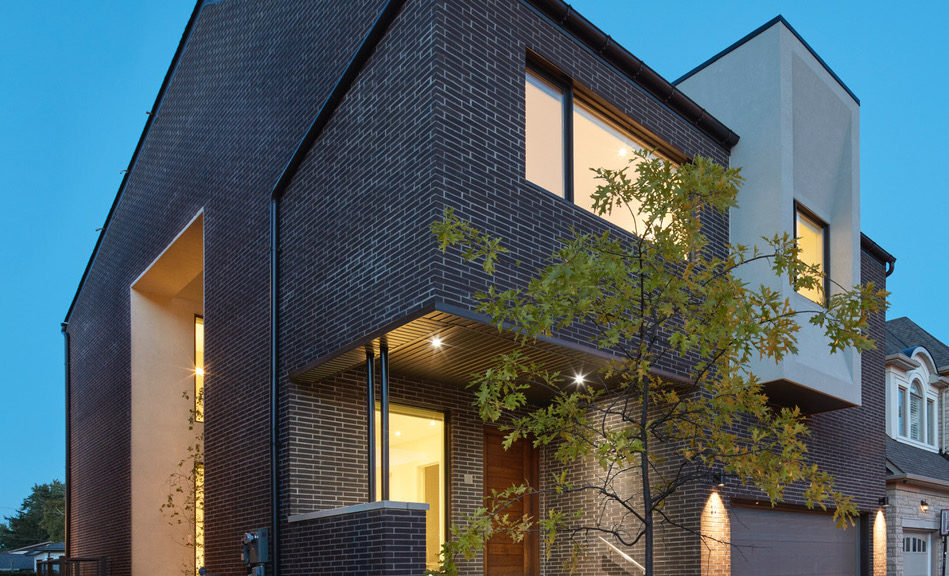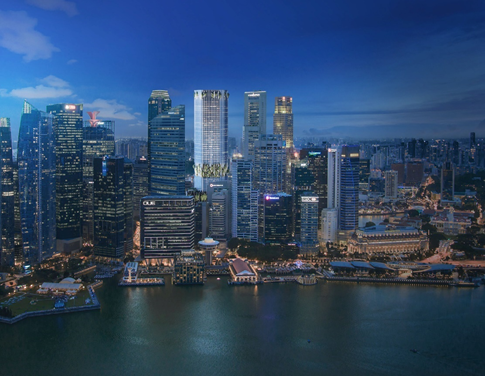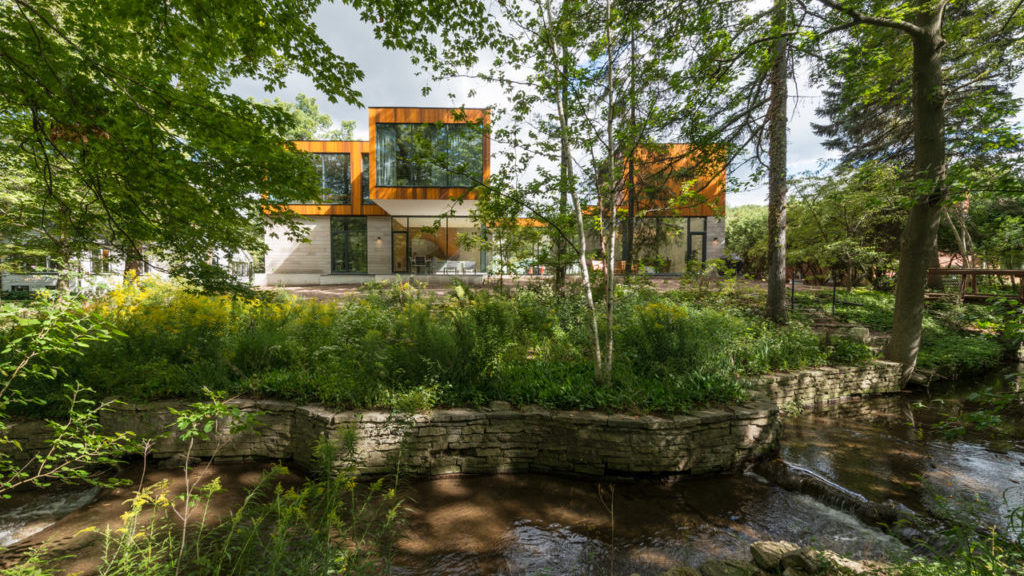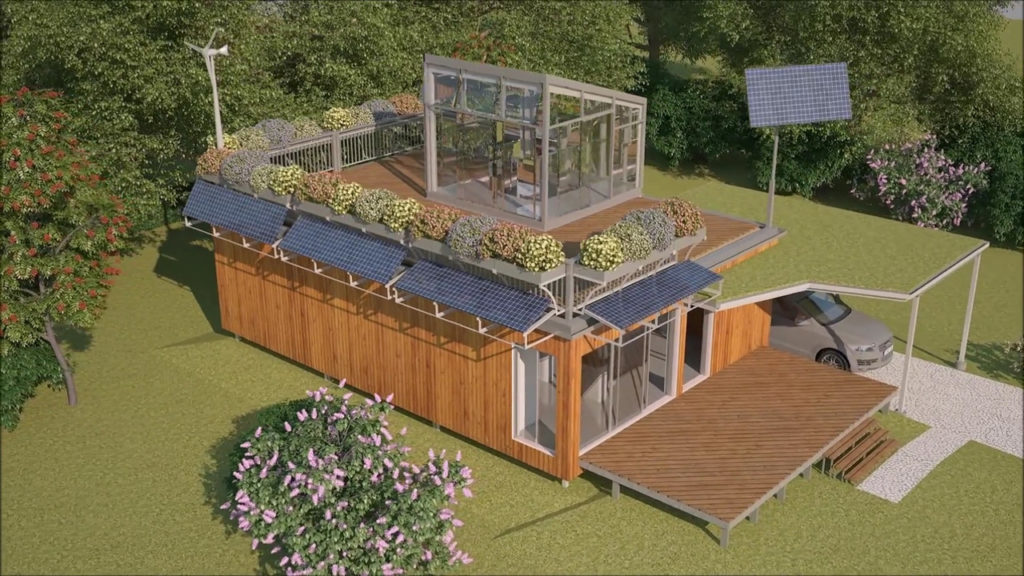All posts by Giulio
Virtual Event Market Forecast 2018-2023
According to Market Research Media the virtual event market will grow from $14 Billion in 2018 to $18 Billion in 2023, with growth rate of 5%, reflecting maturity and commoditization of the virtual event marketplace.
Trade shows are an expensive but necessary part of doing business.
With the cost of your booth rental and all of that extra promotion you could easily spend up to $100,000 per show. I’ve seen a lot of large stands with major corporates with overall bills approaching the seven-figure mark.
And in many ways, beyond the financial implications, a virtual show has much more going for it. A physical trade show can be a hassle for a large corporation and a major logistical nightmare for small and medium players. At a physical convention, hundreds of vendors and thousands of attendees are jammed into a cramped, noisy space. It’s really hard to know who’s worth talking to.
Often, the “little guy” gets dwarfed by the “big boys,” armed with substantial war chests, premium advertising and booth space, as well as high-profile keynote presentation exposure.
Now, thanks to computer technology, the playing field is level.
Imagine a trade show with no costs for transportation, shipping, hotels, hospitality, or booths, and just a minimal cost for exhibit space. That’s a virtual trade show. With travel costs rising and travel budgets falling, more industries are turning to virtual trade shows as a less expensive way to showcase their wares.
Imagine attending a conference or trade show without leaving the comfort of your office. Thanks to the emergence of virtual events, you can attend sessions, meet vendors, and mingle with attendees from the comfort of your desk chair.
Interact with Canada’s most active green building professionals, peruse the newest products and technologies with the click of the mouse and download valuable information to your computer.
Connect with industry peers by interacting through text, audio and video capabilities.
Companies, traditionally, participate in trade shows to generate new sales leads. People attended conferences for content and networking. The same results, as it turns out, can be attained by becoming involved in virtual alternatives such as the Green Building Expo.
“The traditional conference and trade show market will gradually move the way of virtual events, and will continue to adopt virtual technology to either replace physical events where attendance is lagging or complement physical events. It is just a matter of time before the virtual events world and the trade show world merge to create the next generation of events – a hybrid of the old and the new”. (Market Research Media)
For additional information on how to become a Green Building virtual Expo sponsor or exhibitor please call 416-250-0664 or e-mail to greeenbuildingexpomarketing@gmail.com
Pier 2, Apartment of the Future Makes Waves
Humphreys & Partners presented a future vision of multifamily design at the 2018 International Builders’ Show in Orlando. Vice President of Design Walter Hughes revealed a high-rise concept that portrayed renderings of two towers on the Manhattan waterfront.
Pier 2 is the innovative solution to the growing changes in people’s lifestyle and inclusion of technology. It is a new form of dwelling that can improve quality of life and create a greater connection to nature.
The 100 percent sustainable project is designed with modular and micro units, co-working spaces and every amenity a futuristic apartment dweller needs to thrive: artificial intelligence, drones, home automation, autonomous vehicles and a variety of activity and wellness centers.
Starting from the ground up this concept includes: ground level retail space outfitted with smart shopping capabilities, photovoltaic glass, wind turbines, green walls, Tesla energy via Powerwall, vertical farming and park and recreational areas that will have facial recognition technology and other carbon footprint reducing features.
Forward thinking and integrating the latest technology into multifamily projects is Humphreys & Partners’ priority. Pier 2 not only defies conventional multifamily design, but represents the future of multifamily design.
Leading companies in sustainable housing recognized for their contributions and advancements in Ontario’s Green Building category
Ontario’s best Green Builders were celebrated at the EnerQuality Awards Gala (EQ Awards), taking place at the Universal Eventspace in Vaughan, Ontario. Hosted by Breakfast Television’s Kevin Frankish, more than 200 industry peers gathered to share concepts and accolades as together they help to move towards a more energy conscious future.
“Advancing energy-efficient techniques and tools are huge priorities in the building sector to continue to improve healthy living conditions, fight climate change and minimize unnecessary spending,” says Corey McBurney, President of EnerQuality. “The EnerQuality Housing Innovation Forum & Awards help to connect builders with the innovation they need to meet their design goals as well as spotlight the change-makers who are effecting policies and driving standards towards a shared goal of Net Zero housing.”
The EQ Awards were enjoyed by all and featured special designations to highlight the outstanding contributions of industry leaders including:
2017 Hall of Fame Nominee – Larry Brydon, VP Business Development with Cricket Energy
Larry has been in the HVAC distribution and energy services market for more than 25 years. A past chair of Sustainable Buildings Canada and the Toronto Chapter of the Canada Green Building Council, he currently serves on the Board of Directors for the Canadian Efficiency Alliance, the International Initiative for a Sustainable Built Environment (iiSBE), Sustainable Buildings Canada (SBC), and EnerQuality. Among his many achievements, Larry led the Enbridge and Union Gas’s Savings by Design program. This initiative has participated in over two hundred low-rise, and fifty high rise developer design charrettes where they shared energy-efficient design alternatives resulting in 15-25% energy improvement over the Ontario Building Code.
2017 Leader of the Year – Doug Tarry, Doug Tarry Custom Homes Ltd.
2017 was a banner year for Doug Tarry, of Doug Tarry Custom Homes. Fresh off winning the inaugural Net Zero Builder Award from the Canadian Home Builders’ Association, his Project Hope, a fundraising event that was the first time a Net Zero home was built in just three days, raised funds for the family of the late Johnny Nooren, a building inspector from St. Thomas. The project won the 2017 Prestige Award from the Ontario Home Builders’ Association for project of the year – low rise, and the trailer for the accompanying documentary was seen by more than 10,000 in movie theatres in Ontario. Doug Tarry led his team of builders to receive the 2016 EQ Builder Achievement Award and now holds the 2017 title of Leader of the Year for propelling the company’s holistic Net Zero housing concepts with simple controls designed to allow homeowners to save money while living in a healthy environment.
Impact Award – Arista Homes Ltd.
Arista Homes Ltd was awarded the honor of the 2017 Impact Award – an award introduced in 2016 to recognize a builder’s significant voluntary progress in reducing carbon emission and outstanding achievements through energy efficient and sustainability practices. “Green initiatives and ENERGY STAR participation have become staples of our building practices and we remain committed to continuing to improve our building practices and to lead by example,” says Franco Crispino, V.P. of Sales and Marketing. Arista Homes has proudly enrolled more than 1,200 ENERGY STAR® homes since the construction of its first multi-phase ENERGY STAR community in 2009.
2017 EQ Award Winners:
Partner Award
Enbridge Gas Distribution
Union Gas
Owens Corning
Enbridge Savings By Design Award
Remington Homes
Building Innovation Low-Rise
Great Gulf Homes Ltd
Building Innovation Mid/High-Rise
Times Group Corporation
ENERGY STAR® for New Homes Builder of the Year
(Small volume)
sean.ca (Sean Mason Homes)
ENERGY STAR® for New Homes Builder of the Year (Mid-volume)
Remington Homes
ENERGY STAR® for New Homes Builder of the Year
(Large volume)
The Minto Group
ENERGY STAR® Champion of the Year
Jacqueline Collier, Tamarack Homes
Best Green Marketing Campaign
Doug Tarry Custom Homes Ltd
R-2000 Home Builder of the Year
RND Construction
Net Zero Home Builder of the Year
Reid’s Heritage Homes
Evaluator of the Year
Angela Bustamante, Building Knowledge
Builder Achievement Award
Shaun Joffe, Great Gulf Homes Ltd.
Ontario Green Builder of the Year
Sifton Properties Ltd.
About EnerQuality
EnerQuality (www.enerquality.ca) is Canada’s #1 certifier of energy efficient homes and the market leader in delivering award-winning residential green building programs. Founded in 1998 by the Ontario Home Builders’ Association (OHBA) and the Canadian Energy Efficiency Alliance (CEEA), EnerQuality’s mission is to accelerate housing innovation to improve building performance.
Superkül
Active House: a model of sustainable suburban development
By Sarah Hicks
Communications Cordinator Ontario WoodWORKS!
Active House has a vision for the future. It’s one where buildings create healthier and more comfortable lives for occupants, without negative impact on the climate, moving us towards a cleaner, healthier, and safer world. The Active House label is a world-wide quality stamp for comfortable and sustainable buildings. Its metrics emphasize energy efficiency, low environmental impact, and superior occupant comfort.
Active House – Centennial Park is a model for modern, suburban development that sets a new standard of sustainable design for the thousands of new homes built in Canada every year. Wood and panelized wood construction were central in achieving the home’s high level of performance, so the project was a natural standout in the Environmental Award category at the Ontario Wood WORKS! Wood Design Awards.
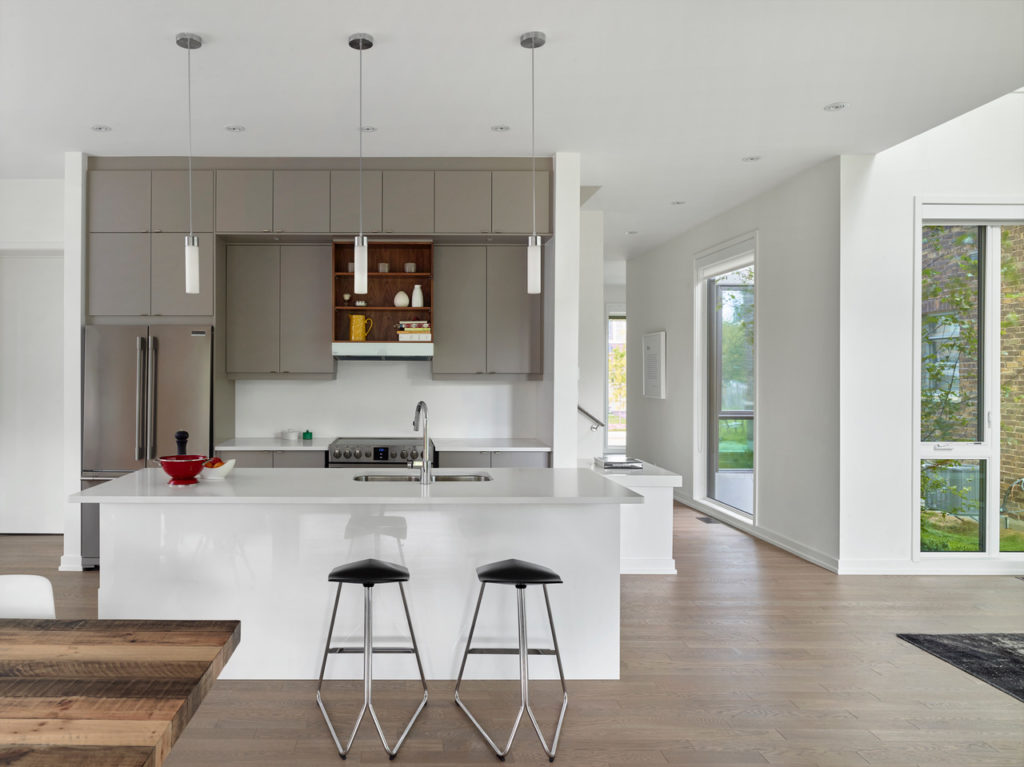
Marianne Berube, Executive Director of the Ontario Wood WORKS! program that hosts the awards, remarked on the use of wood in contemporary construction. “Today’s wood products and systems are technologically advanced. Project teams are using these high-performance building materials in exciting ways, actively and imaginatively exploring wood’s expanding potential. Design professionals who understand the need for sustainable development are increasingly specifying wood products for innovative, environmentally responsible construction.”
Active House – Centennial Park is a prefabricated, panelized wood structure. The wall, floor and roof panels were factory built, flat packed, and brought by truck to the site for assembly. This efficient construction strategy reduced both construction waste and the duration of onsite construction; the frame of the entire house was erected in just a few days.
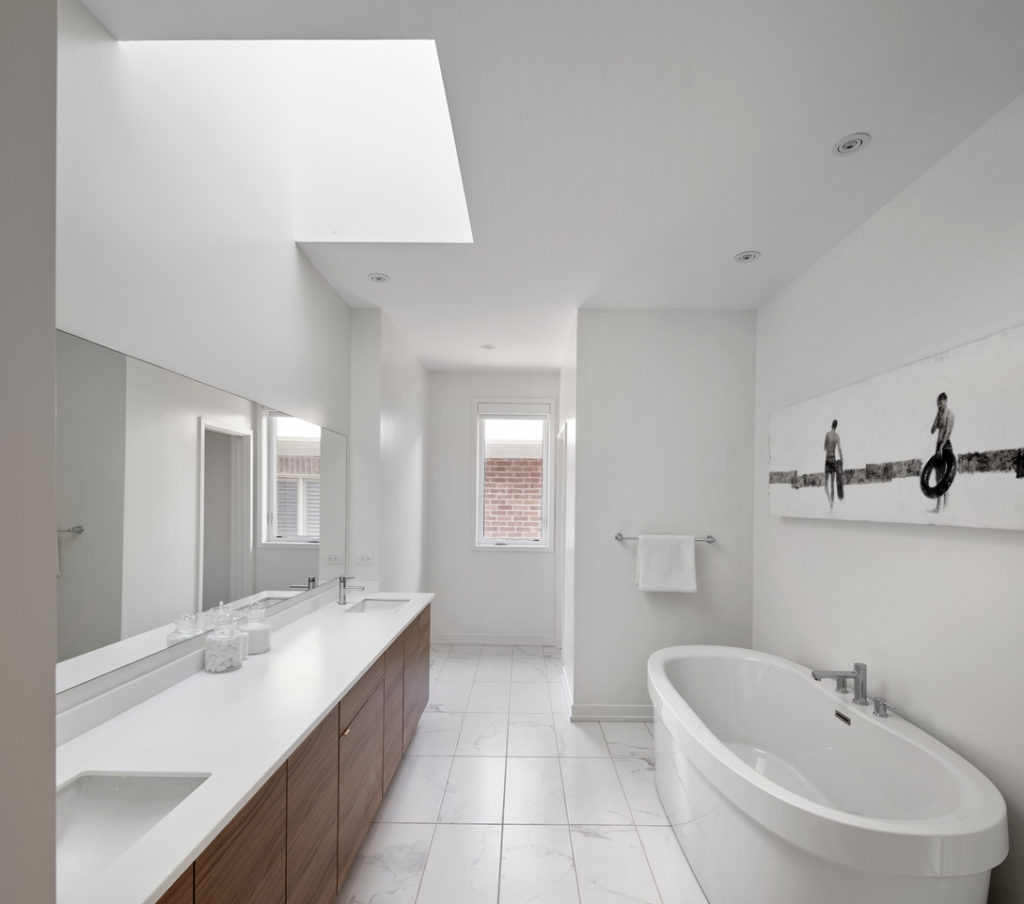
The innovative structural wood roof and wall system has an integrated air barrier that streamlined the weatherization process and vastly simplified and accelerated the assembly of the exterior walls. The system employs an integrated 3-ply exterior sheathing material (rigid Insulation, OSB sheathing and house wrap all in one). Fabrication in a factory setting, using computer generated cuts, optimized material use resulting in minimal waste.
Great Gulf’s H+ME Technology system — an advanced indoor automated manufacturing plant that allows roof, wall and floor assemblies to be built as integrated panels in a controlled environment — was essential to the project’s success. The H+ME Technology facility is supported by construction visualization, prototyping and fabricating technologies that reduce environmental waste and increase energy performance through the manufacture of tight-fitting building components. The system even provides the opportunity to build full-scale mock-ups to verify a project’s energy efficiency.
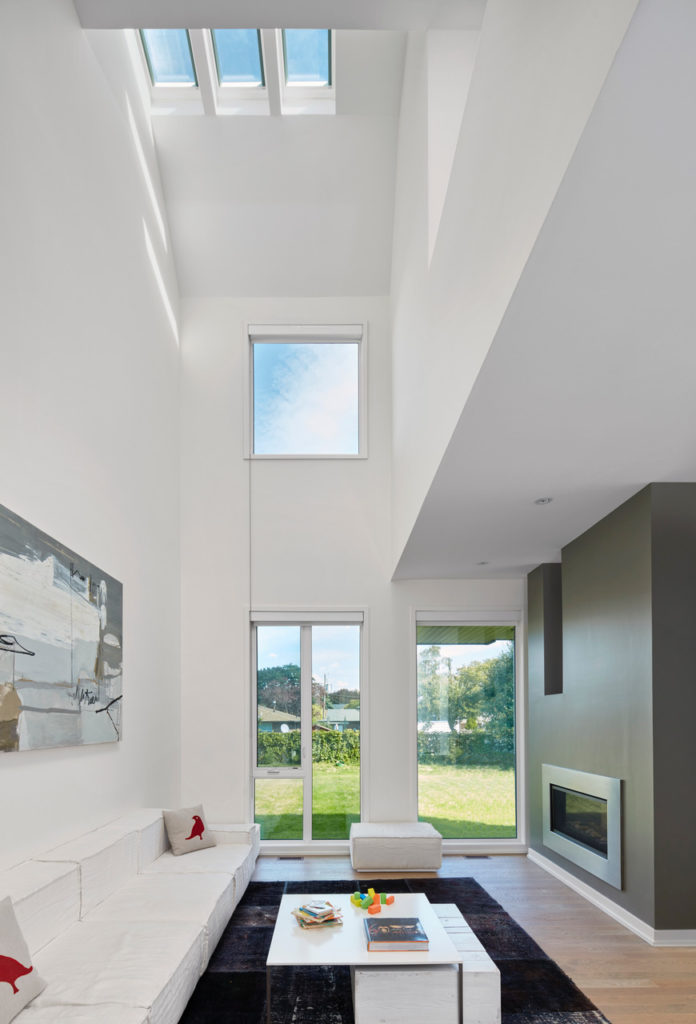
Wood’s environmental credentials and superior thermal comfort over other materials made it the obvious choice on this project. Its low embodied-energy and ability to capture and store atmospheric carbon is unlike any other building product – making it a natural choice for building sustainable, comfortable, high-performance homes.
The house occupies a modest footprint, but enjoys a greater feeling of expansiveness from the amount of natural daylight filtering in through the generous and strategically placed windows and skylights. This strategy also increases the potential for cross-breezes which naturally ventilate the house while decreasing reliance on air conditioning.
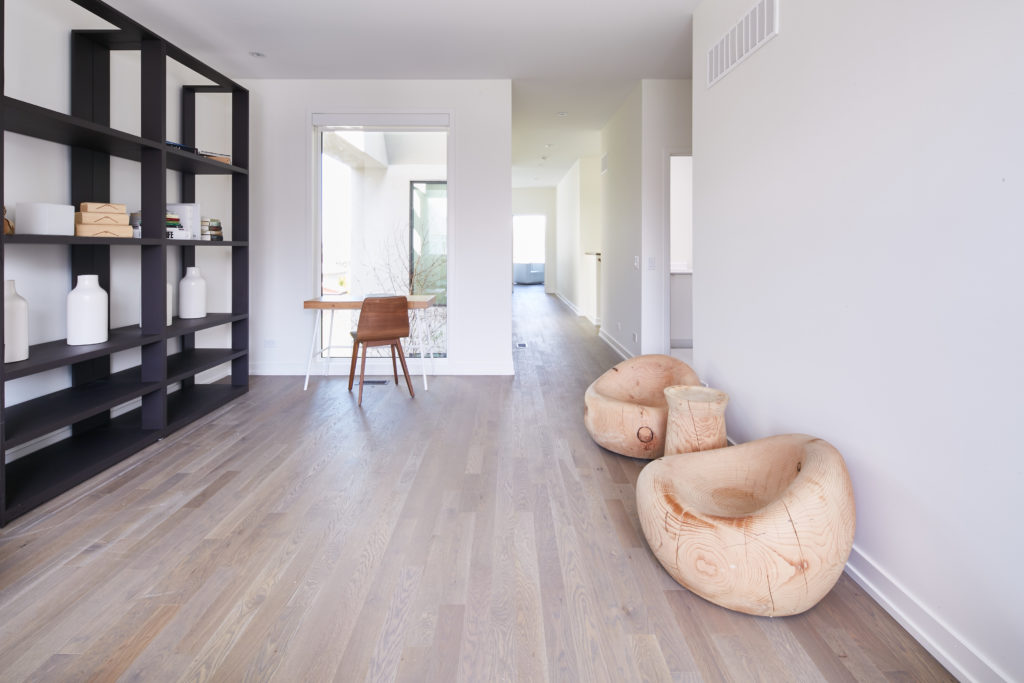
An open-plan configuration with double-height spaces connects all areas of the house without sacrificing privacy, removing visual barriers while creating a greater sense of engagement between family members. Consequently, the home feels far more spacious than its 2,900 square feet. Light and nature is brought further into the house through the provision of a small C-shaped courtyard, with views from all three sides outside to the surrounding flora and fauna.
Specific energy-saving and environmentally conscious features such as interior and exterior LED lighting systems, triple-glazing, low-flow water fixtures, low-VOC finishes and energy-performance monitoring systems complement the primary design strategy of maximizing opportunities for natural daylight and ventilation, ultimately achieving a greater sense of health and well-being for the occupants.
BIG-BJARKE INGELS GROUP – Plant-filled skyscraper in Singapore
BIG & CRA FUSE TROPICAL NATURE WITH MODERN ARCHITECTURE IN SINGAPORE’S NEW TOWER FOR CAPITALAND
The 280m tall high-rise on 88 Market Street, jointly designed by BIG-Bjarke Ingels Group and CRA-Carlo Ratti Associati has broken ground in the bustling Central Business District of Singapore. The tower, one of tallest in Singapore, will redefine and elevate workplace and living standards while adding an elegant new landmark to the Singapore skyline.
Located in the heart of Singapore’s financial district, the new 93,000 m2, tech-integrated and verdurous skyscraper which includes the ‘office of the future’, a serviced residence and retail components, transforms the site of a former car park complex built in the 1980s. BIG and CRA were selected to design the 51-story high-rise following an international architectural competition hosted by Asia’s leading real estate company, CapitaLand. The development funded by the joint venture partnership CapitaLand Limited, CapitaLand Commercial Trust and Mitsubishi Estate Co., Ltd. is expected to be completed in 2021.
“Buildings can no longer be designed with a singular purpose or customer profile in mind – the definition of work is rapidly evolving and will continue to take on new forms. With our deep expertise in developing and managing offices, malls, serviced residences and integrated developments, CapitaLand is in a unique position to lead the charge in creating future-ready, work-live-play developments that will galvanize the community. Anchoring the rejuvenation of Raffles Place, the upcoming integrated development will set a new benchmark for workspaces of the future as we harness the best-in-class design, engineering and smart technologies to empower occupants with new levels of flexibility and mobility. This will be complemented by active placemaking initiatives in the integrated social spaces to build a vibrant work-live-play community. We are excited to embark on this journey to create a sustainable, people-centric development as we lay the blueprint for the workplace of the future.” Mr. Lim Ming Yan, President & Group CEO, CapitaLand Limited.
Rising to 280m, the integrated development offers premium Grade A office space, a 299-unit Citadines serviced residence to be managed by The Ascott Limited and ancillary retail space. The tower is set to make a distinctive mark on the Singapore skyline: the building’s exterior façade consists of vertical elements that are pulled apart to allow glimpses into the green oases blooming from the base, core and rooftop. A dynamic interplay of orthogonal lines and lush greenery presents itself in the contrasting textures of steel and glass, interweaved with tropical vegetation.
“BIG’s design seeks to continue Singapore’s pioneering vertical urbanism with the 280m tall diverse community of places to work, live and play inside as well as outside. At multiple elevations, the facade peels open to reveal urban oases for its users and the surrounding city – animating the elegant smoothness of modern architecture with the ubiquitous tropical nature.” Bjarke Ingels, Founding Partner, BIG.
At the ground floor, visitors will be met by a public rainforest plaza and park. A series of spacious activity pockets invite possibilities for fitness sessions, temporary art installations or other community events. Meandering garden paths and covered passages create natural entryways into the City Room, a 19m-high generous open space at the foot of the tower. The lush exterior will be matched by an array of hi-tech solutions shaping a series of fully responsive spaces for work or leisure. Sensors, Internet-of-Things (IoT) and artificial intelligence capabilities are scattered throughout the tower which will enable the tenants to customize their experience of the building.
The City Room welcomes tenants into separate lobbies for the offices and residences, as well as shoppers and diners into the food centre within the tower’s podium.
The first eight floors of the tower are dedicated to the serviced residence including a wide range of facilities such as a swimming pool, jacuzzi, jogging track, gymnasium, social kitchen, residents’ lounge and barbeque pits. The top 29 floors of the tower offer premium office spaces with panoramic views to the Singapore River and Marina Bay.
At the core of the building between the hardscapes of the offices and residences are four connected levels of organic softscape, called the Green Oasis – a mesmerizing 30m open-air garden for work, casual strolls, relaxation, exercise and events. The multi-leveled oases are connected by a spiraling botanical promenade that creates multiple viewpoints of the vertical park within and the Singapore landscape outside.
“As someone with Singaporean heritage, I’m honored and humbled by the opportunity to contribute to the ongoing evolution of architecture in Singapore – the home of tropical modernism. BIG’s design looks to further this local typology by distinctly yet seamlessly blending the contemporary high-rise with abundant greenery in-between the offices, residences, amenities and recreation spaces.” Brian Yang, Partner in Charge, Bjarke Ingels Group.
The Green Oasis is a tranquil haven of winding walkways and comfortable seating areas for working outdoors or simply lounging in the shade. At about 100m above ground, the tropical garden will feature a jungle gym, treetop cocoons, sky hammocks and a café.
“At CRA, we aim to design spaces that can become settings for novel interactions. In this building, green areas are made accessible to the public at different heights, allowing the city’s exuberance to extend throughout the entire tower. Working in nature will be as essential to the experience of the building as the most advanced digital technologies, offering us a glimpse of tomorrow’s offices.” Carlo Ratti, Founding Partner, CRA; Director, MIT Senseable City Lab.
Images by BIG-Bjarke Ingels Group
HOUSE ON ANCASTER CREEK
Winner of wood design award an owner-driven, intergenerational home
The House on Ancaster Creek is an example of owner-driven development, creating a unique solution to the complex issue of aging-in-place.
The project in Ancaster, Ontario, has won the WoodWorks 2017 residential wood design award. It constructs a scenario for living that allows for autonomy while mutually benefitting from proximity. It confirms that sustainable systems and designing for the elderly are not exclusive from modern expression and exquisite details. As the family changes so can the family home.
The wide lot backing onto Ancaster Creek is the site for an intergenerational home for a family, including elderly parents. The house was conceived as two distinct residences, each formed into a linear bar containing the full program of a home. The bars sit perpendicular to each other, creating a landscaped courtyard setback from the street, and stack at the corner.
Ancaster Creek and its associated floodplain traverse the property. This site is one of 596 private properties that accommodate forest, wetland, meadow, and aquatic habitat in this protected area. The house is located at the back of the property in close proximity to the creek, while respecting the meander line to avoid the floodplain and erosion hazards of the watercourse. The landscape moves through the house, creating a natural context and denying the collection of McMansions that have been developed around the site and attempt to contextualize it as suburban instead of as connected to the land.
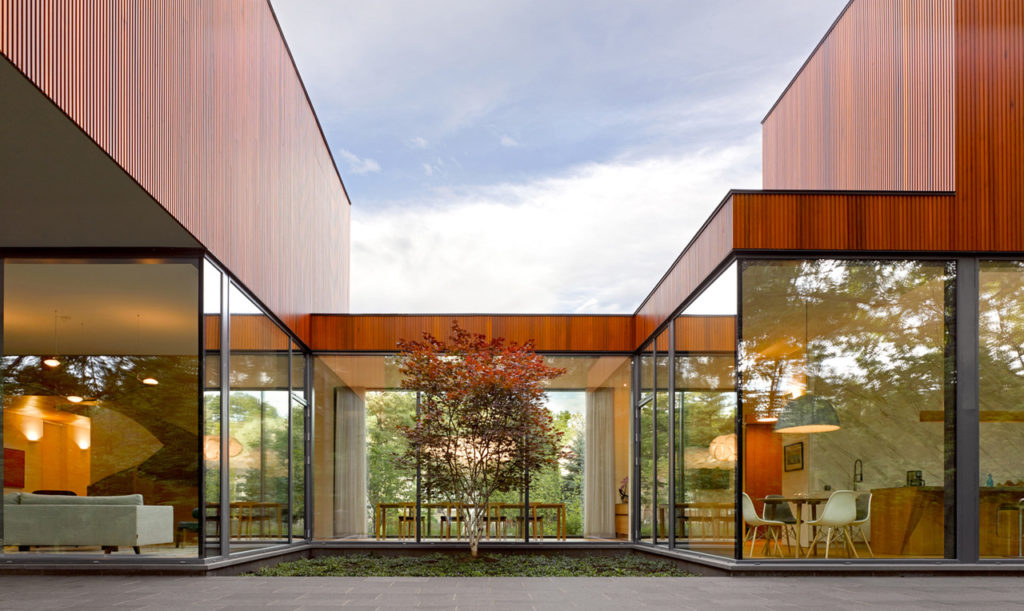 Williamson & Williamson[/caption]The parents’ suite occupies the ground floor with the living and dining space anchoring the view. The suite is laid out as a single floor accessible apartment with added features to accommodate the specific challenges facing the aging parents. Among them, well-located drains and a master power switch mitigate issues that have come with memory loss: a sink left running, or an oven left on. A second bedroom and bathroom are adjacent, but separate, for a live-in relative or nurse.
Williamson & Williamson[/caption]The parents’ suite occupies the ground floor with the living and dining space anchoring the view. The suite is laid out as a single floor accessible apartment with added features to accommodate the specific challenges facing the aging parents. Among them, well-located drains and a master power switch mitigate issues that have come with memory loss: a sink left running, or an oven left on. A second bedroom and bathroom are adjacent, but separate, for a live-in relative or nurse.
Running parallel to the creek is the main residence. The kitchen anchors the south end of the house. Set in a double height volume, the 20-foot-tall pyramidal ceiling creates an expansive space that opens to the creek, the courtyard, and above to the sky. Back-painted glass and polished Calacatta slabs are meticulously detailed to reflect the surrounding landscape and contrast the heavy, flat-sawn solid oak island with a faceted base.
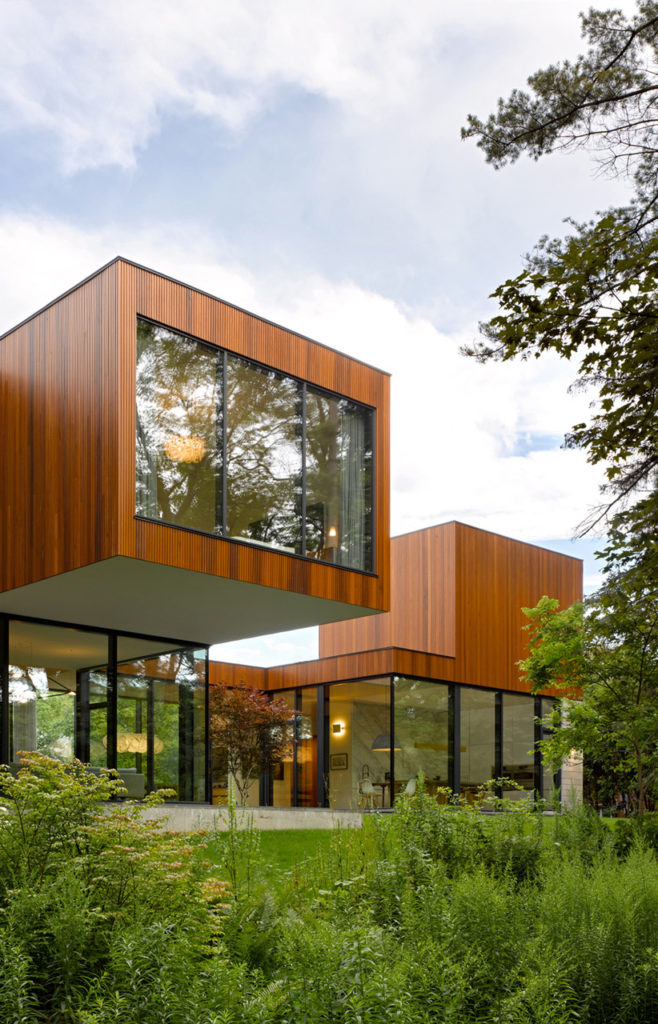 Williamson & Williamson[/caption]The dining room occupies a glazed link pinched between the landscape that flows from the creek, through the courtyard, and to the front of the house. The living room, with a honed travertine fireplace and oak wall rendered in the form of the exterior cladding, extends under the cantilever in the summer months, doubling in size. These social spaces are shared by the extended family. A connected hallway that is easy to navigate for the parents leads around a softened corner and draws the family together.
Williamson & Williamson[/caption]The dining room occupies a glazed link pinched between the landscape that flows from the creek, through the courtyard, and to the front of the house. The living room, with a honed travertine fireplace and oak wall rendered in the form of the exterior cladding, extends under the cantilever in the summer months, doubling in size. These social spaces are shared by the extended family. A connected hallway that is easy to navigate for the parents leads around a softened corner and draws the family together.
The grand gesture of a wood-clad spiral staircase connects the living room to the second floor master suite, creating a unique moment in the otherwise orthogonal room and celebrating the connection between floors. The curvature opens as it rises and becomes the ceiling of the adjacent wing, creating a pinwheeling effect that leads to the parents’ suite.
Structured with sheets of laminated plywood, the white oak railings become thin, curved, structural elements that bridge between the floors. The complexity of this system is seen in the connections between the layers, with the two sides tied together by the treads, effectively treating the tight, inner spiral as a post.
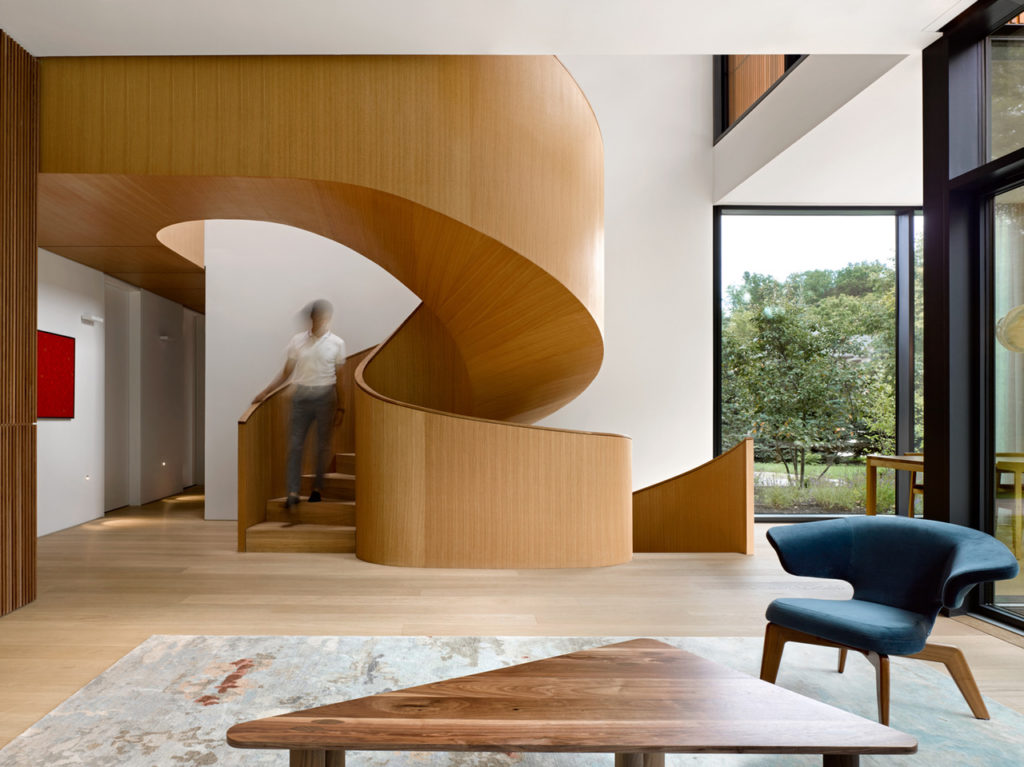 Williamson & Williamson[/caption]The small second floor acts as a private suite. A lounge with concealed bar extends from the large landing, a custom oak library painted a soft blue provides an office space, a light-filled cantilevered bedroom reaches out into the best views of the creek and a serene bathroom clad in gray marble tiles sits across a linear walk-in closet.
Williamson & Williamson[/caption]The small second floor acts as a private suite. A lounge with concealed bar extends from the large landing, a custom oak library painted a soft blue provides an office space, a light-filled cantilevered bedroom reaches out into the best views of the creek and a serene bathroom clad in gray marble tiles sits across a linear walk-in closet.
With sustainability at the forefront of the design process, the requirement of material durability and longevity was paramount. Careful detailing of local materials achieves this. The ground floor of the house is clad in 3-1/2-inch thick locally-quarried Algonquin limestone which meanders around the perimeter.
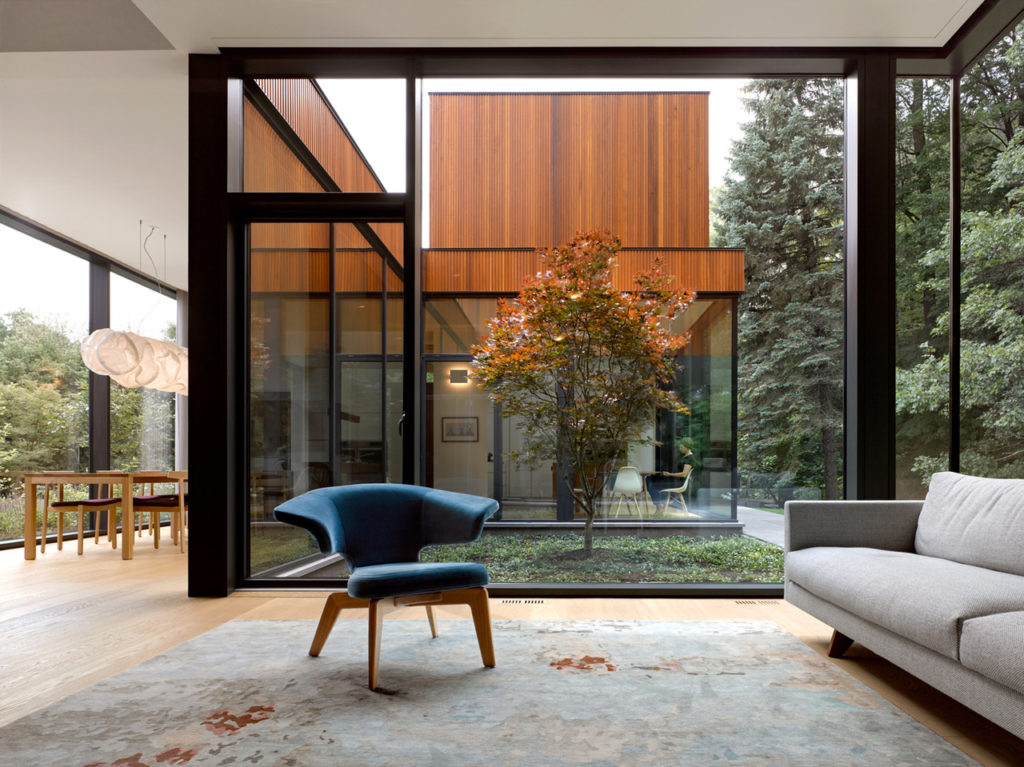 Williamson Williamson[/caption]
Williamson Williamson[/caption]
The coursing is designed to highlight the compression and layering that forms this sedimentary rock. Twelve-inch-tall stones at the top-most course compress to four inches at the bottom. The horizontal joints are raked deep and the vertical joints are filled flush to emphasize the horizontality of the rock. Milled cedar clads the upper volumes of the house. One-by-six boards were milled with thin shadow lines that create depth in the material and emphasize the verticality of wood’s natural state. A three-part finishing system extends the life of the wood and stretches the time required between maintenance work.
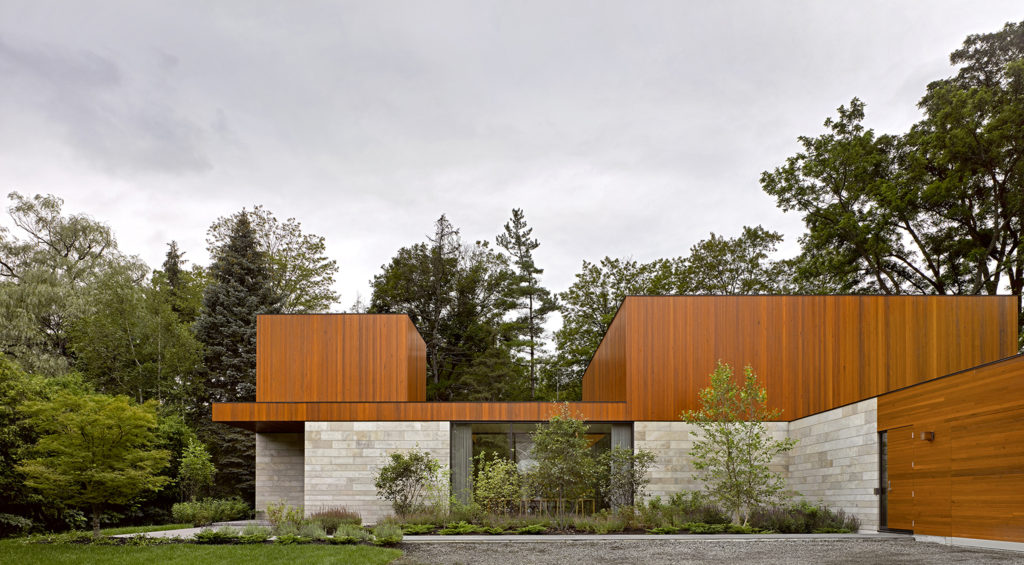 Williamson & Williamson[/caption]
Williamson & Williamson[/caption]
To reduce the ecological footprint, energy consumption was decreased through a number of key moves. Most importantly, two families are now living on a single-family lot, increasing density without increasing building area. Second is the envelope: High-performance glazing systems, including triple-pane wood-frame windows with an average Uw (heat loss rating) of .77, anchor the highly insulated envelope. Radiant floor heating can then be used sparingly and only to compliment a high efficiency furnace. Finally, a 37 module 9.8 kW Canadian made solar array was installed across two of the flat roofs, offsetting energy consumption. Combined with LED lighting, these measures culminate in a low-energy home that sits comfortably in this northern climate.
Web / wwinc.ca
Williamson Williamson Inc. is the architecture and design studio led by Betsy Williamson, OAA, and Shane Williamson, Associate Professor and Director of the Daniels Faculty’s Master of Architecture program at the University of Toronto. Practice-based recognition includes the Ronald J. Thom Award for Early Design Achievement and the Professional Prix de Rome for Architecture from the Canada Council of the Arts, the Emerging Architectural Practice Award from the Royal Architectural Institute of Canada, and the Young Architects Prize and the Emerging Voices Award from the Architecture League of New York.
WOHA ARCHITECTS – Living green tower in downtown Singapore
Oasia Hotel Downtown Offers a Living Prototype for Commercial High-Rise Development
The Oasia Hotel Downtown, designed by Singapore-based WOHA Architects, presents a radically different face to the world than its glassy neighbors in that city’s central business district.
The structure incorporates 25 species of creeper plants into its permeable aluminum façade, giving the high-rise a character that is both unique and indicative of the architects’ conception of design for the high-density, yet green city. WOHA’s design for Oasia Hotel Downtown moves beyond vague notions of “sustainability” by fundamentally embracing living systems into a mixed-use program—one that grows, rather than exhausts a city’s resources.
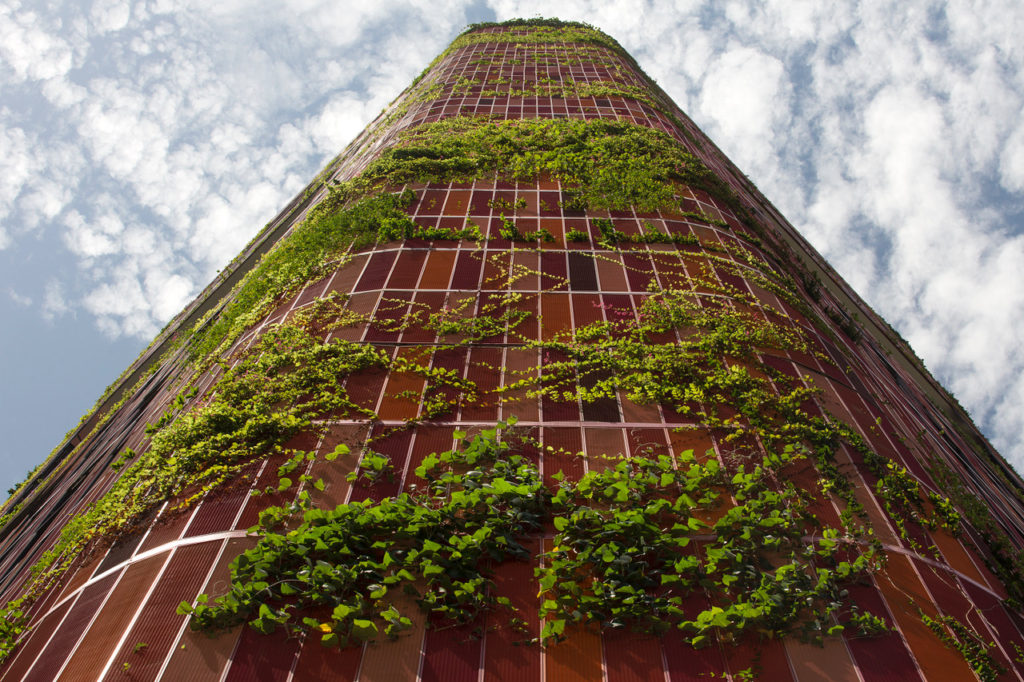
While buildings most often stand in opposition to nature, replacing green with grey, WOHA’s work proposes that even our highest density built works can amplify living greenery within urban space. Oasia Hotel Downtown actively contributes a lush, living ecosystem to the city, from footprint to skyline, by producing over 1000% of the greenery found on the site prior to its construction. Over time, the tower’s open terraces, sky gardens and blossoming façade will evolve into a lush and permeable envelope.
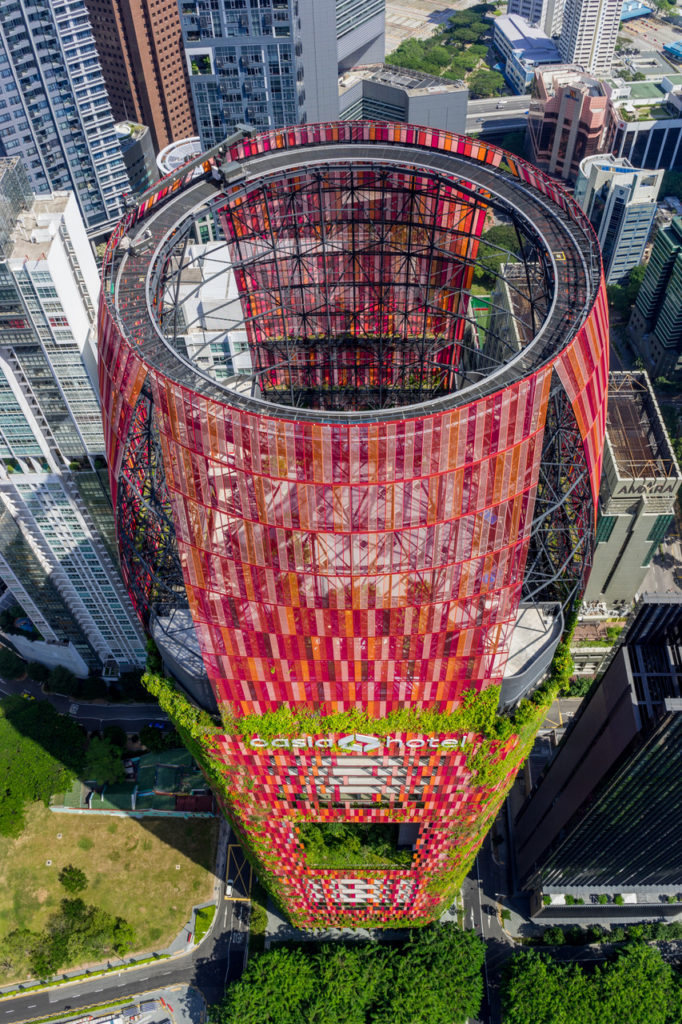
With the Oasia Hotel Downtown structure divided into both hotel and office uses there was a great need for a circulation plan that could support varied uses and allow for individualized open spaces. WOHA’s plan of distributing necessary elevator and building service cores to the four corners of the building allows for generous open spaces on the 6th, 12th, 21st and 27th floors. As WOHA principal architects Richard Hassell and Wong Mun Summ are keen to point out, this distribution scheme allows the rare pleasure of standing in the center of an upper sky terrace and taking in a 360-degree view.
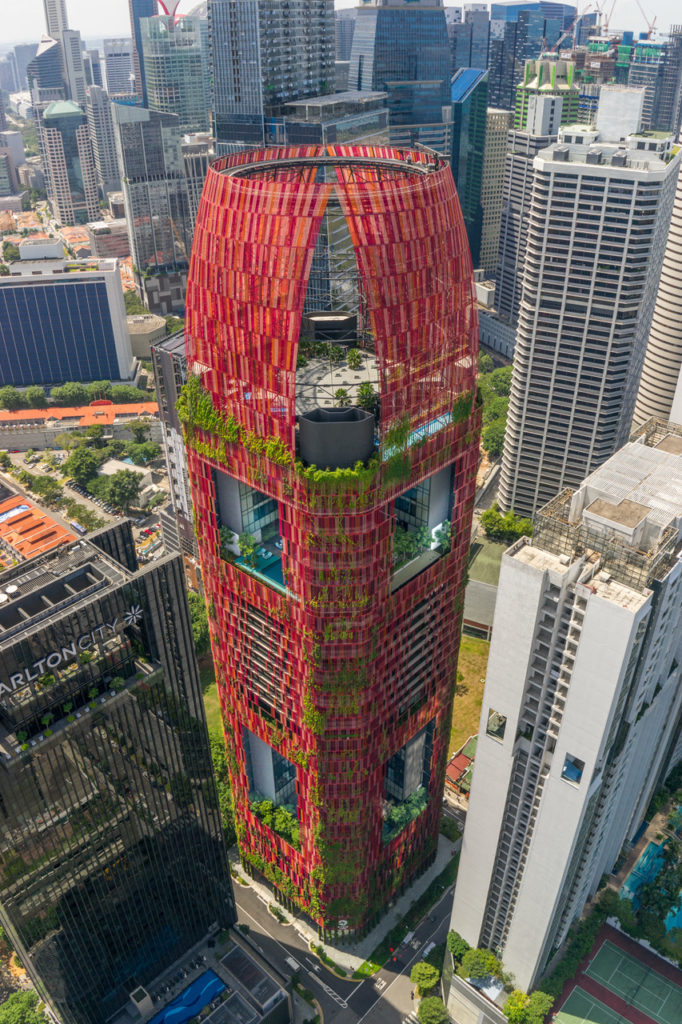
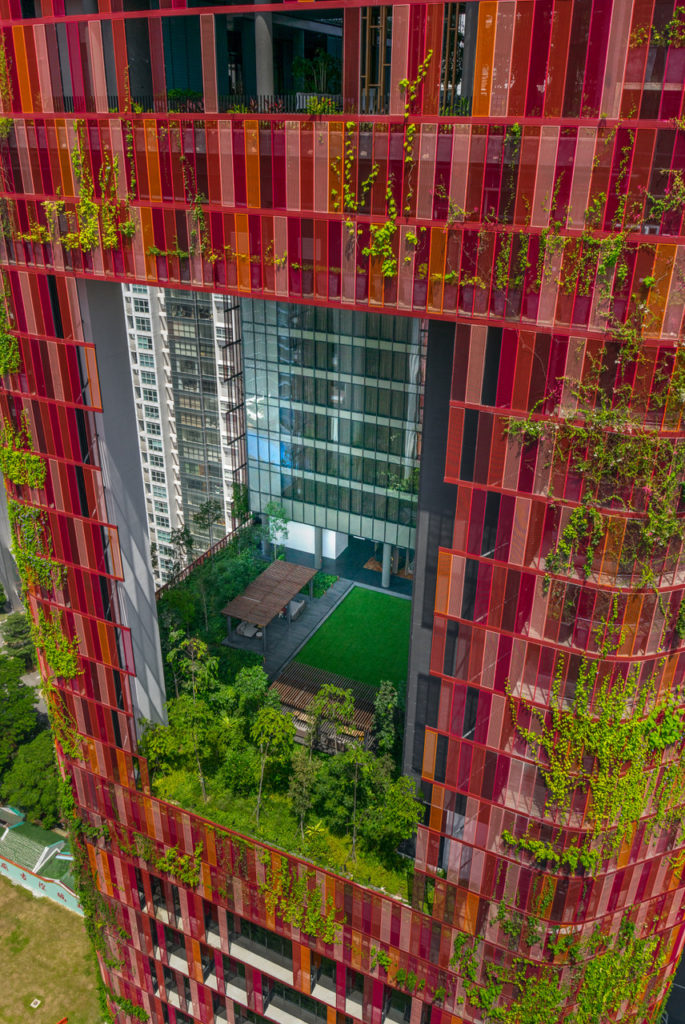
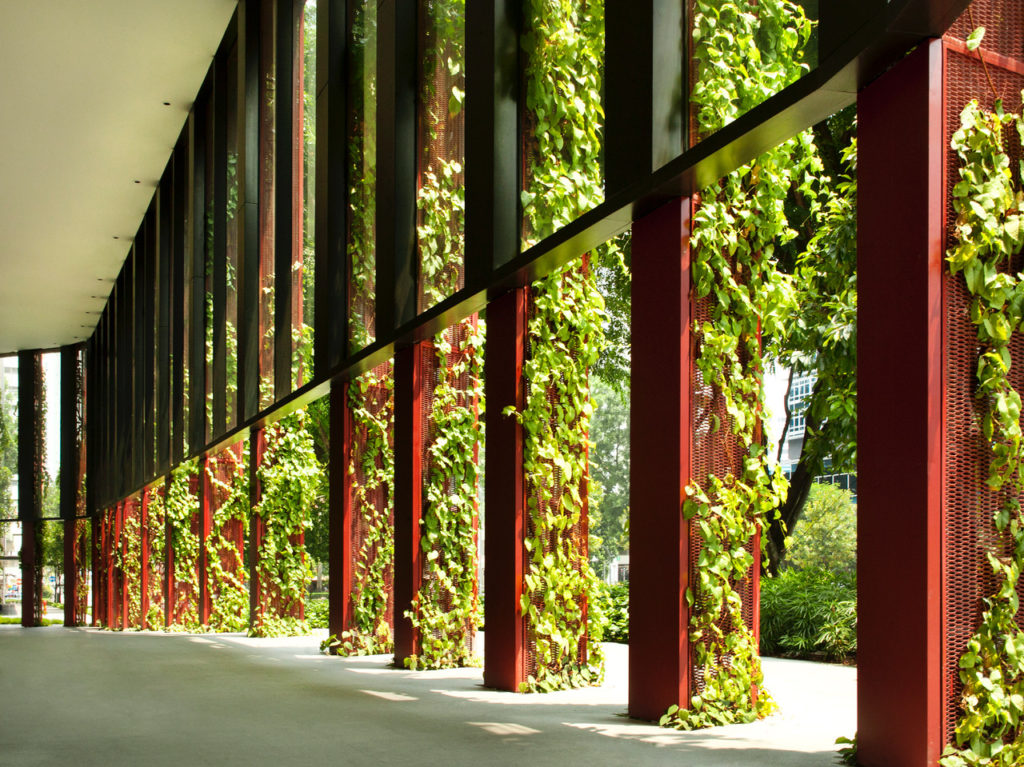
Singapore’s newest tower breathes life into the upper reaches of the CBD skyline. This architectural prototype, with its naturally ventilated shared spaces and growing material palette, is a novel architectural experience, whether from afar or from within. Moreover, in keeping with the Singaporean firm’s extensive experience and expansive repertoire, Oasia Hotel Downtown embodies WOHA’s vision of high-rise, high-amenity architecture that responds to the complex conditions of megacities and the broader Global South.
Fast forward
Flexibility of Flexsola design key to creating sustainable and environmentally-friendly housing
Nicholas Varias is an innovator, plain and simple.
The president of Flexsola International Development Corporation has a lengthy cutting-edge track record dating back to the 1980s. But the culmination of his ground-breaking design efforts to create affordable, adaptable and environmentally-friendly housing just might be his latest design – the Flexsola.
“The construction sector is lagging behind in terms of innovation,” says Varias, a Canadian architect, artist and writer, whose company is based in Burlington, Ontario. “And that’s especially in respect to dealing with climate change. Flexsola can bring a much-needed contribution.”
Flexsola is a modular system for creating sustainable and environmentally-friendly multi-use developments. Its flexibility makes it affordable and adaptable to peoples’ needs as they change over time. Its functional flexibility can provide lifetime residency, opening the way for the creation of a stable, caring and economically-sustainable community.

“Flexsola will appeal mainly to first-time homebuyers and seniors,” says Varias. “That’s thanks to its capability of constructing small units and then expanding them as needed. Cost-wise, for construction, we are aiming for a maxiumum of $150 per square foot.”
A patented steel saddle connection is at the heart of the Flexsola modular building system. This novel approach facilitates the creation of space modules, which can be added, removed, or relocated within a three-dimensional rectangular grid. The flexibility and affordability of Flexsola modular building system make it an ideal solution for an ever-increasing demand in homes of all types and other uses.
“The steel saddle is the key feature of the system,” explains Varias. “It expedites the installation of the posts and beams, and permits the addition or relocation of modules.”
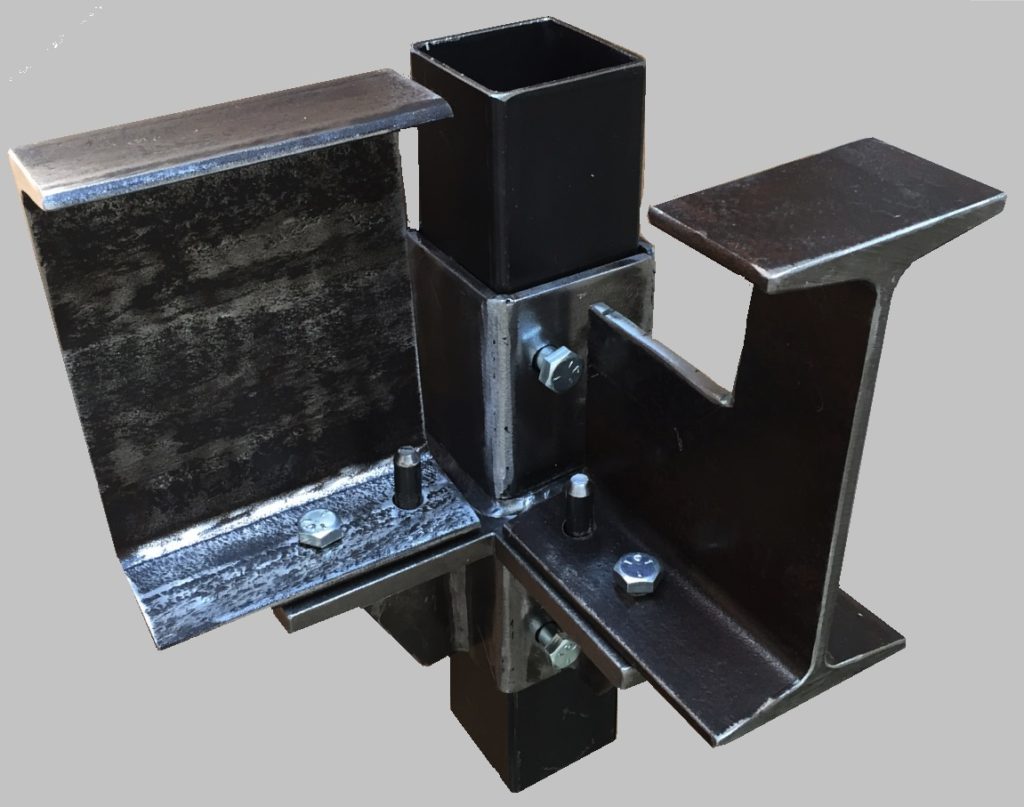
The Flexsola system can be used for a wide range of applications and modules can be made to any size or shape for easier transport. In addition, localized assembly plants can be utilized to increase design flexibility through the use of more complex module shapes. The system can be adapted to all forms of housing currently available on the market, with the added benefits of unprecedented flexibility and adaptability. It is also ideal for infill developments and can be easily integrated into the existing urban fabric.
A Flexsola building system property will be more attractive and economically viable than conventionally-built buildings, says Varias. Economic projections indicate that initial investment could be recovered over a few years if advantage is taken of all the potential financial benefits of using this system.
Where a large percentage of the purchase price of a home comes from a mortgage, a conventional house often remains a liability for a long time, despite its growing equity. In contrast, a Flexsola building is a financial asset because of savings not found in conventional buildings. Some examples:
- Lower construction cost resulting from prefabrication and the unique modular system further enhanced by the use of the saddle connection system, which speeds up the erection of the posts and beams;
- Reduced insurance costs;
- Long-term lower costs of energy consumption and maintenance;
- Revenue generating options due the functional flexibility of the floor plan (i.e. rental of a secondary unit, or home-based business);
- Electricity generation revenue;
- And relocation potential of the entire house, or of some of its modules.
Varias says a Flexsola building system has a low-carbon footprint because of very important features, such as of its innovative steel structures, landscaped rooftops, and unique devices to generate solar and wind energy.
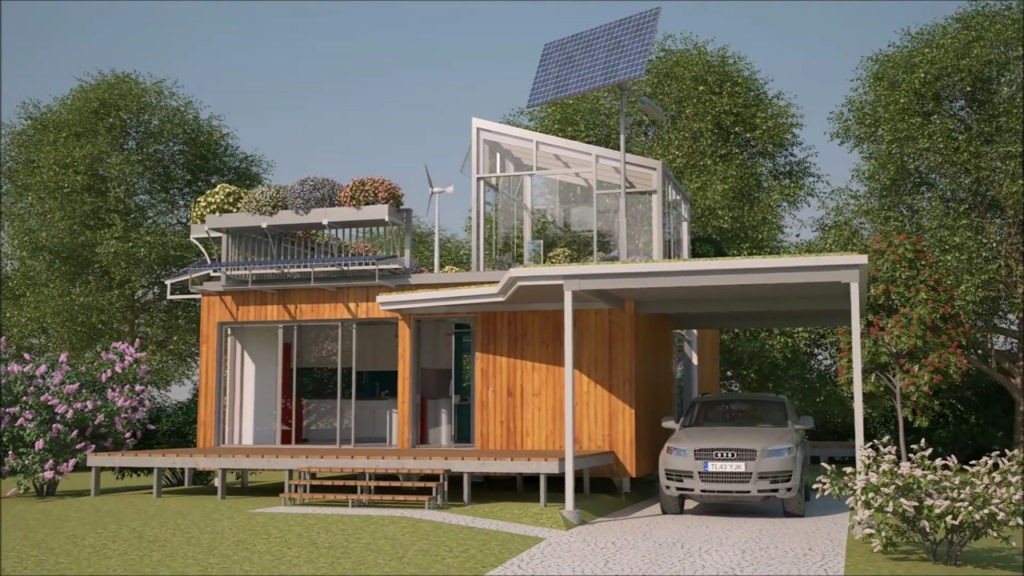
According to the Flexsola president, a building produced and erected in this system will also be more sustainable than alternative structures. This is why:
Quick erection on site due to off-site fabrication and the patented saddle;
- Ease of transportation;
- Steel is 100 per cent recyclable and can be recycled indefinitely, the only “cradle-to cradle” recycled material in the world;
- Durability and longevity;
- Steel is a long-term investment that does not go to waste;
- Steel manufacturing and fabrication to exact specifications causes minimal waste;
- Flexsola system buildings will consume less energy through heating and cooling than other buildings of similar size if clad with approved off-site produced sustainable cladding materials to give the highest level of thermal fabric performance;
- The system can outperform conventional construction in virtually every sustainability criteria including acoustic performance, air tightness, thermal performance and durability. It requires less maintenance by adhering to rigorous quality standards during assembly in the factory;
- And enhancement to Flexsola energy reduction benefits include additional options such as green/sedum roofs, parapet and post mounted PV panels and mini wind-turbines.
Web / flexsola.com
Flexsola International Development Corporation has been awarded the 2017 Innovative Product Award by Toronto Construction Association. In 1996, Varias won the Canada Mortgage and Housing Corporation’s FlexHousing Design Competition and a model of his design was built in 1997 at the Canadian Centre for Housing Technology in Ottawa.







